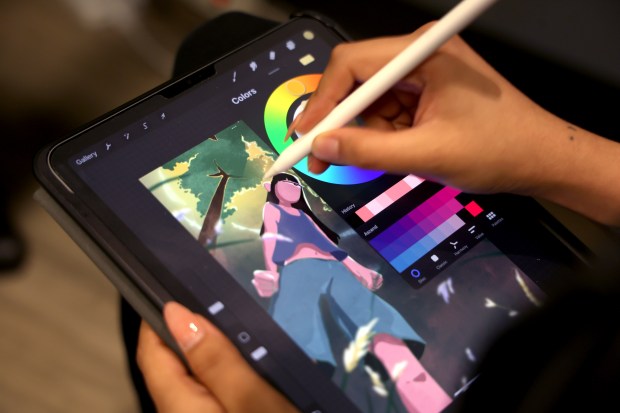Nitya Mehrotra uses her skills as an animator to create more than just art — she’s building a community.
The East Lakeview grad student is the founder of an online platform called Stories by Strangers that supports the physically and mentally abused.
Mehrotra, 23, created the safe space for abuse survivors to anonymously share their struggles and trauma. It’s an outlet to help others with similar stories that also provides resources for those still coping. According to the site, over 2,000 stories have been submitted via email since 2023.
Mehrotra, who uses the pronouns she and they, collaborates with people who submit their stories to create art that reflects their individual narratives. Mehrotra, who’s pursuing a master’s degree in film and animation at the School of the Art Institute of Chicago, then animates the art for a short that features the survivor’s words accompanied by music.
The shorts showcase gender neutral cyclops characters — with names such as Kuku, Oli, Bib and Vitra — set against a backdrop of moody colors that are posted on an Instagram account with over 43,000 followers. It usually takes her a week to do two animations.
“I give them an idea of how they can represent themselves (in the story),” Mehrotra said. “Since it’s a collaborative process, they tell me if they would like to customize the character in a way that helps them take more control of the story or maybe makes them feel better about it.”
Changing colors or the way the character looks are both possibilities.
“I collaborate with the person who submitted the story to craft a vision that they like,” Mehrotra said. “What features would they like (their character) to have? Do horns on the head give you more power and control over the telling of this traumatic story? We do all of this over email. … I ask questions, they explain their vision, and based on that, I come up with these fantastical looking animations.”
She said making the characters abstract figures allows people to feel comfortable sharing their stories, which mainly come from people age 16 to 24. “Most people are trying to share success stories because they want to share that you’re not alone and it does get better,” Mehrotra said.
“Stories by Strangers” animations aim to disrupt the flow of desensitized media portrayals of abuse, she said.
“One thing that is very specific to the ethos of this project is not to censor,” she said. “The whole idea is to make sure the story is told the way the storyteller needs to tell it. I ask them: Are there any parts of it that you would not like me to put on social media? And I edit that out for them. But apart from that, there’s no editing.”
Part of the story submission process includes queries such as: Would you like to be contacted by a therapist? Mehrotra responds to everyone who submits stories with resources and outreach. Although her primary collaborations are with people in South Asia, she has also found people through nonprofits, including End Violence Against Women. She’s trying to make more inroads stateside with therapists willing to volunteer their services. Mehrotra has also connected with an art therapist for a collaboration set to begin in August.
Since 2020, Mehrotra has compiled a makeshift team of artists and therapists abroad that volunteers with “Stories by Strangers.” They help her go through stories and have conversations with the contributors.
Mehrotra juggles her commitments for the platform with classes and and her work, which entails serving as a teaching assistant at SAIC and assisting the next generation of artists at Urban Gateways, an arts nonprofit. In her down time, she’s collaborating on a short film with someone who shared a story on the site about being a refugee in Chicago.
“They’re sharing how their family’s mental health suffered in the process of fleeing from their country,” Mehrotra said. “They’re trying to focus on how, ‘Yes, we faced a lot of political problems and physical issues, but the main thing that we all have to stick with for the rest of our lives is the mental health that it destroyed.’”
Coming to the United States at age 17 for her undergraduate degree, Mehrotra said the impetus for “Stories by Strangers” stemmed from her hometown of Delhi, India. The city often gets ranked as unsafe for and by women. Mehrotra said that in 2020 she was angry about the persistence of the data and used her art to address it.
“Once I realized that I could produce art, I realized that this was one way I am able to express that anger,” she said. “The method of attacking or the weapon of attacking changes, but it’s still very present. I talked to my father about it, and he showed me a lot more articles and facts, like 1 in 3 women worldwide will experience some sort of physical or sexual violence in their life. Reading that was heartbreaking for me. … That was my breaking point where as a young person, I was like, ‘I gotta do something.’ I am an artist. So I built upon that with my art.”

She began building the “Stories by Strangers” community when she started putting her own artwork out for the public as someone who is adamant about talking about sexual violence awareness. They were animations and videos that centered on consent and mental health related to trauma and post-traumatic stress disorder.
The response she received was positive and garnered trust, which led to the growth of the online community. Mental health professionals reached out to her along with fellow artists who wanted to help people.
One collaborator in Bangladesh, who joined Mehrotra’s team after becoming disillusioned with the way corporations and nonprofits work, wanted to help young women with a more direct approach. “I knew that these people are actively seeking help and bettering themselves,” the collaborator said in an email. “Even though I was not doing in-person work with you. … I hope I can help more in the future.”
Mehrotra said people find solace from the anonymity that the platform offers. The website doesn’t collect identities from the storytellers. Providing a name, email and a country of origin are optional. An email is used solely to continue the conversation with Mehrotra to post the story. She says she gets submissions from countries around the world.
“I think that attests to the site’s power. … Even when you don’t attach an identity to a story, it speaks to everyone and that I think speaks to how great it is that all of these abstracted figures find a way to relate to people’s stories all around the world,” Mehrotra said. “After getting stories from many countries, one thing I’ve realized is that people are the same everywhere. If a problem exists in India, a problem exists in Chicago; if a problem exists in Chicago, it exists somewhere else. It’s just the priority is given very differently.”
Mehrotra hopes those who encounter “Stories by Strangers” are inspired to act — to support survivors, to support queer artists and to support those who are talking about the female narrative. She said there’s a difference between just being aware and offering tangible support.
“I found my way to filmmaking through painting … understanding I want to talk about trauma in a form that I know visually can imprint in someone’s mind,” she said. “When I was younger, I always wished my paintings could move and that’s 100% the reason that I went into animation. Maybe the idea of collaboration with all the people who tell their stories also comes from this, because I want to be able to turn a story into a visual that can be experienced (in a way that is helpful) rather than hurt.”



